MnDOT/FHWA Precast Slab System Workshop Summary Report
September 8, 2005
Background
Increasing traffic volumes, an aging highway bridge infrastructure, and dwindling resources are increasing the need for State DOTs and the Federal Highway Administration (FHWA) to look for innovative ways to more quickly construct longer-lasting bridges while minimizing traffic disruption. Prefabricated bridges are one means of addressing this need. Depending on specific site conditions, the use of prefabricated bridge systems can minimize traffic disruption, improve work-zone safety, minimize environmental impact, improve constructibility, increase quality, and lower life-cycle costs. To learn the latest prefabricated bridge technologies in other industrialized countries, the FHWA, the American Association of State Highway and Transportation Officials (AASHTO) and the National Cooperative Highway Research Program (NCHRP) sponsored the Prefabricated Bridge Elements and Systems (PBES) International Scan in April 2004. The PBES scan team was most interested in prefabricated bridges with span lengths in the 20 to140 ft range because the majority of the bridges in the United States are in this range.
While visiting France, the PBES scan team learned of an innovative precast slab superstructure system, called the Poutre Dalle System, that addresses the need to quickly construct longer-lasting bridges. The Poutre Dalle System consists of shallow, inverted tee-beams that are placed adjacent to each other and span between supports. The beams are connected with a longitudinal joint; 180-degree hooks extending from the sides of the tee-beams and additional reinforcement provide continuity along the joint. Cast-in-place concrete is placed between the tee-beam webs and over the tops of their stems to form a solid composite cross section. Figure 1 shows photos of the French Poutre Dalle System.
a. Moved from fabrication bed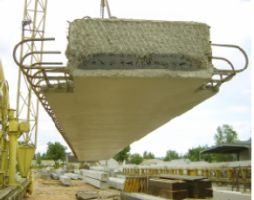 |
b. Erected at the bridge site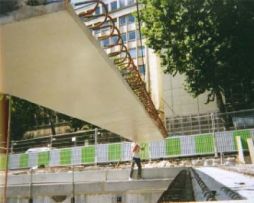 |
The Poutre Dalle precast segments can be erected in a day for a typical bridge. The system can readily span from 20 to 82 ft, with a maximum span of 105 ft. The beam width is controlled by the shipping weight of 27.5 tons and is typically 16 to 79 in. The overall composite depth for simple spans is 1/28 to 1/30 of the span length. The system is certified by the French National Railway Authority (SNCF) and the Technical Department for Public Works and Transportation (SETRA) and is proprietary in Europe. It is being used in Europe because of the advantages listed below:
- Provides a precast solution with a range of sizes
- No falsework is necessary
- Can be placed across highways in service
- Short delivery time
- Does not require skilled labor for erection
- Bottom surface is smooth
- Thinner deck resulting in higher vertical clearance
- Fast construction
- Economical construction
- Provides a safe working platform.
Impressed with the Poutre Dalle System, the PBES scan team included it as one the ten technologies recommended for implementation in the U.S. While a few similar inverted tee-beam bridges have been constructed in the U.S., the connection joints for these bridges continue to be a durability concern. The Poutre Dalle's connection details are anticipated to provide better continuity with improved long-term performance.
The scan team's implementation plan included obtaining sample drawings, specifications, and photographs of construction details and completed bridges for posting on a web site; proposing research to validate the loop joint detail; and soliciting states for demonstration projects. The September 8, 2005 Minnesota Department of Transportation (MnDOT)/FHWA Precast Slab System Workshop showcases the first two demonstration projects in the U.S. to result from the scan team's implementation plan. Dan Dorgan, State Bridge Engineer and Director of the Bridge Office at MnDOT, was a member of the scan team and is leading this effort.
Minnesota Implementation of the Precast Slab System
MnDOT is currently constructing two precast slab system bridges with details similar to the Poutre Dalle System. Both projects used stage construction to accommodate traffic flow during construction to avoid long detour routes. Instrumentation under a research study at the University of Minnesota was included for one of the projects.
The first project is T.H. 8 over the Center Lake Channel near Center City in Chisago County. The three-span bridge (22 ft - 27 ft - 22 ft) replaces an existing culvert. The shallow depth of the precast slab system meets the desire to allow recreational boat traffic between the lakes at this location.
The second project is T.H. 72 over the Tamarac River near Waskish in Beltrami County. The three-span bridge (45 ft - 45 ft - 45 ft) replaces a deteriorated three-span voided slab built in 1962. Again, the shallow depth of the precast slab system met the hydraulic capacity requirements at this location.
MnDOT/FHWA Precast Slab System Workshop
The MnDOT/FHWA Precast Slab System Workshop was held at a conference facility in Vadnais Heights, Minnesota, to showcase MnDOT's first two precast slab system bridges. The one-day program consisted of presentations in the morning and a field trip to the first project construction site in the afternoon.
Dan Dorgan welcomed the participants to the workshop and explained the origin of the new precast slab system now being implemented in Minnesota. Dan was followed by his assistant in the Bridge Office, Keith Molnau. Keith welcomed the attendees and served as moderator for the workshop. The workshop was attended by 144 participants from MnDOT, other state DOTs and agencies, FHWA, county and city governments, precasters, contractors, industry, academia, and consultants. See Figure 3.
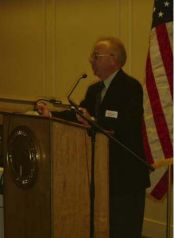 |
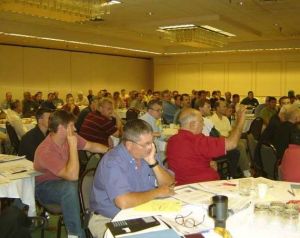 |
Workshop Presentations
The morning presentations are listed below.
- "International Prefabricated Bridge Technology" by Benjamin Tang, FHWA
- "Living Life in the Fast Lane: US Efforts on Accelerated Construction" by Vasant Mistry, FHWA
- "Framework for Effective Decision Making" by Mary Lou Ralls, consultant
- "U.S. Projects Involving Precast Short Span Applications & Rapid Construction" by John Dick, Precast/Prestressed Concrete Institute
- "Impact of Hurricane Katrina on I-10 Bridges in Louisiana" by Arthur D'Andrea, Louisiana Department of Transportation and Development
- "Accelerating Low Volume Bridge Replacement in Iowa (Boone County & Madison County Experience)" by Eugene Calvert, Collier County Transportation Services Division
- "MnDOT Precast Slab System Development" by Kevin Hagen, MnDOT Bridge Office
- "Fabrication Issues and Building of the MnDOT Section" by Don Hall, County Materials
- "Construction Perspective" by Steve Kordosky, MnDOT; and Bruce Riehl, Lunda Construction Company
Benjamin Tang, the FHWA Co-Chair for the PBES scan, gave the first presentation. He began by discussing the drivers that initiated the PBES scan: increasing traffic demand and urban congestion, the public demand for rapid project delivery, safety and mobility needs, and environmental impacts. He then discussed the countries visited and the ten technologies that were recommended for U.S. implementation, including the Poutre Dalle System. He also discussed current implementation efforts and how the attendees could assist in the effort.
The second presentation by Vasant Mistry discussed the advantages of using accelerated bridge construction and cited several specific prefabricated bridge projects in which the projects were completed quickly and under budget.
In the third presentation Mary Lou Ralls discussed findings from a recent survey to state bridge engineers on what they needed most to install PBES in hours or days. One identified need was education and training on the use of prefabricated bridge systems; the workshop and decision-making framework that FHWA is developing are two activities to address this need. Mary Lou then discussed the framework, which is a tool that decision makers, designers and project managers can use to better understand the needs, costs, and technical issues related to the effective use of prefabricated systems for a particular bridge location.
John Dick then discussed various U.S. projects that have utilized short-span precast components to quickly construct bridges. He cited several projects in which the onsite construction required only days to complete. He also mentioned various methods being used to simplify construction, such as the use of spread footings for foundations when soil conditions permit their use.
In the fifth presentation, Arthur D'Andrea discussed the impact of Hurricane Katrina on the I-10 bridges in Louisiana and the significant work that will be needed to repair and replace the numerous bridges that were impacted by the hurricane. Numerous spans were swept off their supports, and many more are out of alignment. Current efforts are underway to realign spans and use temporary bridge systems as needed to restore traffic flow.
Gene Calvert discussed the use of prefabricated systems for rural bridges. He discussed the significant number of deficient county bridges and the need for prefabricated systems that can be quickly and economically installed. In many cases long detour routes require rapid onsite construction. With the majority of the short-span bridges, county engineers must be innovators and initiate the use of prefabricated systems to address their needs.
In his presentation, Kevin Hagen discussed the development of the precast slab system for the first two Minnesota bridge projects. He stated that this system is a practical solution that combines the advantages of precast girders and cast-in-place slab spans, without the need for falsework. Other advantages include reduced environmental impact at the site, improved quality due to the controlled conditions possible with precasting the components off-site, the simple onsite construction methods, and rapid construction. He also mentioned that the projects had additional funding through FHWA's Innovative Bridge Research and Construction Program. Keith said that the bridges were designed by the AASHTO Load and Resistance Factor Design (LRFD). He also said that the project plans are available on the MnDOT website and that MnDOT would be developing standards for this section.
The eighth presentation was by the precaster, Don Hall. Don discussed the various issues related to fabricating a new beam shape. He used new steel forms on a 120-ft self-stressing bed to fabricate the precast slab beams. A secondary forming system was developed to accommodate the bars that extended from the sides of the beam. He commented that the 50-kip beams with their maximum 6-ft overall width allowed standard hauling, and that the beams were erected quickly. Don said that his operations could fabricate two 50-ft segments every other day, with a minimum of six 50-ft segments per week.
The last presentation was by Steve Kordosky with MnDOT and Bruce Riehl with Lunda Construction Company, the contractor for the projects. They discussed the costs, time, equipment, and construction sequence for the projects. The bid cost was $864,000 compared to the engineer's estimate of $643,000. Costs were higher for these first projects because of the risk associated with the new bridge system and the equipment and logistical requirements to install the precast substructure. A larger crane capacity was required to install the 75-ton precast abutments; the 30-ton precast pier caps did not require special equipment. They noted a two-week time savings using the precast slab system.
Keith Molnau gave closing remarks, thanking the presenters and the attendees and discussing details of the afternoon trip to the job site. Box lunches were provided prior to loading buses and traveling to the site.
Site Tour
The workshop was held at a conference facility near the first project, the T.H. 8 bridge over Center Lake Channel near Center City in Chisago County, to facilitate the afternoon trip to the bridge site. The program at the site included a presentation by researchers from the University of Minnesota; the researchers discussed the instrumentation plan for the bridge. The workshop participants then observed construction details and discussed various aspects with MnDOT and contractor staff. See Figure 4.
Participant Feedback
Participants were asked to complete a form for their feedback prior to leaving the workshop. The form consisted of the following questions.
- Please provide your comments on the technology presented at this workshop.
- How do you plan to implement this technology in your state?
- What collective services do you see that FHWA or AASHTO might undertake to promote this technology? Or is this something you can do on your own?
- Please provide your comments on the decision-making framework, e.g., what other criteria you would like to see included, how it could be improved to better serve your needs, etc.
The participants responded positively to the technology presented at the workshop and expressed the need for this and additional technologies to more quickly construct bridges at the site. A number of respondents are planning to work to implement this or other prefabricated bridge systems in their states. They also stated the need for FHWA and AASHTO to continue efforts to assist them in advancing bridge technology to achieve rapid onsite construction, with workshops similar to this one and with tools such as the decision-making framework.
a. Researchers discuss instrumentation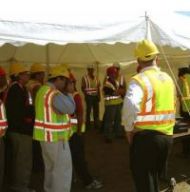 |
b. Participants observe construction details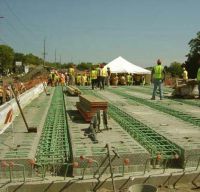 |

